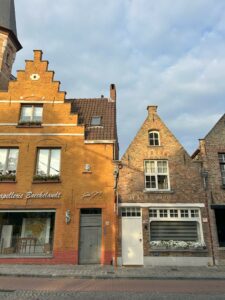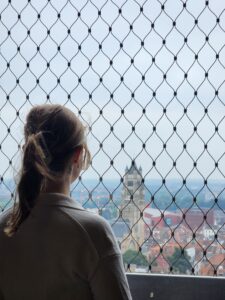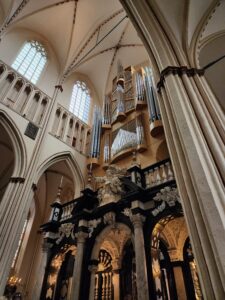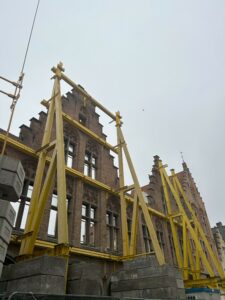Day 1 – 04/09/2024
Our first day in Brugge was actually a travel day moving from the capital city of Brussels, to the smaller quaint city for our second stop. We travelled by train through Belgium’s National Railway getting the opportunity to see the countryside, waterways, other small towns, and some bigger cities including Ghent. We were both surprised by the number of bike racks and paths at every train station (the sheer number was overwhelming as you would never see anything like this in Canada).


With our arrival in Brugge we were both shocked to see such unity and strong character from the city with all the wonderfully preserved buildings down every street and around every corner. We also both enjoyed the energy of the city compared to Brussels. The historical center of Brugge having a much stronger sense of character demonstrating a lack of modern additions/interventions, winding historical canals, and a larger historical center that expands to the outer residential areas. Giving many reasons for its designation as a World Heritage City by UNESCO for its Outstanding Universal Value as a maintained medieval historical settlement, original Gothic constructions, and its historical and current role as a commercial and cultural capital.


Some of highlights of the city from our first walkthrough of the historic center;
The differing gable roof styles throughout the city, varying from crow-stepped to sprout, or a simple sloped roof, and anything in between. Wall ties, wall ties, wall ties! Almost every masonry building in Brugge has wall ties, which provide connections between orthogonal masonry walls, and allow for the transfer of lateral loads.



Ezelpoort (Also known as Donkey’s Gate) it is one of 4 remaining gates of Brugge’s second city wall built in 1297. The gate has undergone multiple restorations and alterations throughout the centuries. This was also connected to beautiful part of the Canal.


Day 2 – 05/09/2024
Our second day in Brugge, we decided to explore the city by visiting some of its main historical landmarks by foot, including Brugge’s Belfry, the St. Savior’s Cathedral and walking along the canals (lots of walking today). We started the day climbing up the spiral staircase – a total of 366 steps – to the top of the Brugge Belfry. We got an amazing view of the city, and even got to see the mechanisms which run and chime the bells (super loud) which ring every 15 minutes. It was also interesting to see the historic timber joints and metal keys holding the structural timber system together of the tower.




We also visited St. Savior’s Cathedral, which is one of the three structures that dominate Brugge’s skyline. The apse of the cathedral and how gorgeous the ribbed vaults and stained-glass windows were quite outstanding along with the integration of the structural tie rods. We were very lucky this evening getting some sun. The canals, and parts of the city really light up in a way you can’t see with an overcast sky. We loved all the wildlife and plants in the canals, especially the swans.




Day 3 – 06/09/2024
We followed a similar plan to the previous day exploring the historical city center, visiting churches, shops and eating some typical Belgian food throughout the city! Our first stop was again to St. Savior’s Cathedral (also known as Sint-Salvatorskathedraal). We only had a short look the previous day as we visited around closing time, and got to properly see the interior of the structure. We followed up with some hot chocolate at Olivier’s, which was absolutely delicious, but also left us feeling a little chocolated out.




Next, we went to the Basilica of the Holy Blood, which looks small from the outside, but holds two floors consisting of a lower and upper chapel built between 1134 and 1157. We were both genuinely surprised by the upper chapel, as we thought the lower chapel was the only section of the basilica. The contrast between the two is quite jarring, due to their size, and the feeling you get walking within the two spaces. One being small, dark and simple, although providing a cozy, protected feeling with candles lit throughout, while the upper chapel being quite grand with lots of natural light, and much more architectural detailing and ornamentation.




We spent the rest of our afternoon walking through the canals and the city. We also visited the torture museum, which definitely left us with a sick stomach after (the building itself is actually one of Europe’s oldest prisons).




Day 4 – 07/09/2024
For our last day in Brugge we spent our time around the outer edges of the historical city center, walking through more residential areas and parks with the goal of reaching Minnewaterpark. This large park is located in the south part of the city and holds open green space for residents to relax, for sitting in the grass, or exploring the gardens. A funny highlight were the green metal chairs that could be moved around the park, allowing visitors to sit wherever they like. Within the park there was also the Castle Della Faille, a 19th-century neo-gothic castle, which was rehabilitated into a restaurant, Kasteel Minnewater!




Following, we then visited Brugge’s Beguinage, which is listed as a UNESCO world heritage site which is known as “Ten Wijngaarde”. This closed community space was where unmarried women lived and supported each other’s spiritual and material needs. This movement began in Brugge around the 13th century, and the community is still inhabited to this day! The site was very serene!


We spent the remaining part of the day exploring the shopping district, and other areas in the historical center walking the cobblestone streets, and enjoying our last evening in this amazing Belgian city.




Next Stop: Amsterdam, Netherlands
You can read our more detailed travels and discussion in our Instagram posts here!
